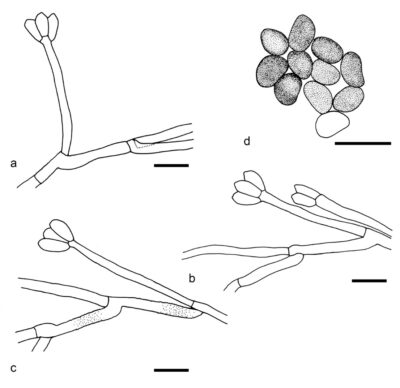Fungalpedia – Note 310, Cymostachys
Cymostachys L. Lombard & Crous
Citation when using this entry: Perera et al. 2024 (in prep) – Fungalpedia, genera described in 2016.
Index Fungorum, Facesoffungi, MycoBank, GenBank, Fig. 1
Classification: Stachybotryaceae, Hypocreales, Hypocreomycetidae, Sordariomycetes, Pezizomycotina, Ascomycota, Fungi
Lombard et al. (2016) erected Cymostachys for a group of stachybotrys-like taxa that produce irregularly cymosely branched conidiophores and olivaceous brown to dark brown, fabiform conidia. Furthermore, they are distantly related to Stachybotrys s. str. in the phylogenetic analysis of cmdA, ITS, rpb2, and tub2 (Lombard et al. 2016). The conidiophores are macronematous, mononematous and arrange mostly in groups. They are erect, septate, irregularly cymosely branched, and hyaline to subhyaline, with thin and smooth to slightly verrucose walls. The conidiophores generated 3–6 phialidic conidiogenous cells from the apex. Conidiogenous cells are clavate, olivaceous brown to dark brown at the apex and turn hyaline to subhyaline towards the base. They also have smooth to slightly verrucose walls and distinct collarettes. Species of this genus produce olivaceous brown to dark brown conidia aggregates in dark slimy masses. The conidia are aseptate and fabiform to globose and have rounded ends and smooth to verrucose walls. However, the sexual morph remains undetermined (Lombard et al. 2016). Cymostachys species are associated with plant parts (Lin et al. 2016; Lombard et al. 2016). The genus currently includes five species (Index Fungorum 2024).
Type species: Cymostachys coffeicola L. Lombard & Crous
Other accepted species: Species Fungorum, search Cymostachys
Figure 1 – Cymostachys coffeicola (CBS 252.76, ex-type). a–c Conidiophores d Conidia. Scale bars: a–d = 10 μm. Redrawn from Lombard et al. (2016)
References
Entry by
Rekhani Hansika Perera, Center of Excellence in Fungal Research, Mae Fah Luang University, Chiang Rai, 57100, Thailand.
(Edited by Kevin D. Hyde, Samaneh Chaharmiri-Dokhaharani, & Achala R. Rathnayaka)
Published online 27 August 2024
